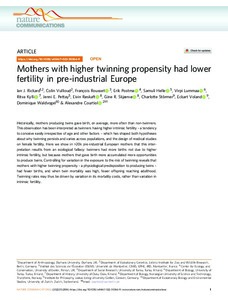Mothers with higher twinning propensity had lower fertility in pre-industrial Europe
Helle Samuli; Rousset François; Skjærvø Gine R.; Voland Eckart; Waldvogel Dominique; Kylli Ritva; Störmer Charlotte; Røskaft Eivin; Vullioud Colin; Pettay Jenni E.; Rickard Ian J.; Courtiol Alexandre; Postma Erik; Lummaa Virpi
Mothers with higher twinning propensity had lower fertility in pre-industrial Europe
Helle Samuli
Rousset François
Skjærvø Gine R.
Voland Eckart
Waldvogel Dominique
Kylli Ritva
Störmer Charlotte
Røskaft Eivin
Vullioud Colin
Pettay Jenni E.
Rickard Ian J.
Courtiol Alexandre
Postma Erik
Lummaa Virpi
Nature Publishing Group
Julkaisun pysyvä osoite on:
https://urn.fi/URN:NBN:fi-fe2022081154737
https://urn.fi/URN:NBN:fi-fe2022081154737
Tiivistelmä
Historically, mothers producing twins gave birth, on average, more often than non-twinners. This observation has been interpreted as twinners having higher intrinsic fertility - a tendency to conceive easily irrespective of age and other factors - which has shaped both hypotheses about why twinning persists and varies across populations, and the design of medical studies on female fertility. Here we show in >20k pre-industrial European mothers that this interpretation results from an ecological fallacy: twinners had more births not due to higher intrinsic fertility, but because mothers that gave birth more accumulated more opportunities to produce twins. Controlling for variation in the exposure to the risk of twinning reveals that mothers with higher twinning propensity - a physiological predisposition to producing twins - had fewer births, and when twin mortality was high, fewer offspring reaching adulthood. Twinning rates may thus be driven by variation in its mortality costs, rather than variation in intrinsic fertility.
Kokoelmat
- Rinnakkaistallenteet [19207]
